

 The South African
The South African
By J J M Coetzee
Member of the ground staff of 15 Squadron from November 1941 to May 1944
(Unless indicated otherwise, photographs are author’s own)
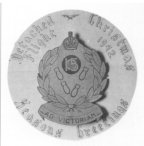
We arrived at Suez on 13 February 1 942 and boarded a train to take us to Amariya, near Alexandria, from where we were taken to the base camp a few miles further south. The landing ground was a featureless, flat piece of desert from which the scrub had been cleared, and where sandbag blast-shelters, which were to house the aircraft we were to receive, had been built. We were told that we were to be equipped with Bristol Blenheim MK IV fighter aircraft.
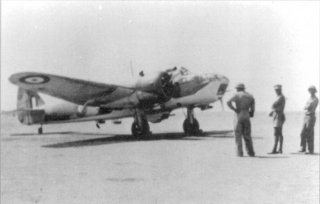
RUNNING UP THE ENGINES OF THE BRISTOL BLENHEIM MK IV
(NOTE THE CANNON IN THE NOSE AND THE VENTRAL PACK.)
These machines were fitted with a 20mm cannon firing through the nose, a ventral gunpack of four .303 Browning machine guns in the left wing and a dorsal turret with two .303 Brownings. In addition, they could carry four 2501b (113,4kg) bombs. They had a radius of action of about 400 miles (640km) and an absolute range in still air of about 895 miles (1 440km). These Blenheims were powered by two Bristol Mercury XV radial air-cooled engines of 995 horsepower each. One of the idiosyncrasies of the engines was that taking off with the cooling gills open was not advisable. Several crashes and near crashes occurred as a result of such an oversight. Although the Blenheim MK IV was obsolescent as a frontline aircraft, it nevertheless remained a suitable choice where enemy air opposition would likely be on a very small scale.
The squadron was also advised that it was to send a detachment to the Kufra Oasis in the south-eastern Libyan desert, which was considered of strategic importance. The Allies considered that this oasis could be used as a base from which offensive and/or defensive reconnaissance and harassing operations could be carried out. However, if not occupied by the Allies, the enemy could use it as a base for hostile air or land action against the Nile valley. That would endanger the whole of the Middle East, as well as the air routes between Egypt and West Africa along which new aircraft were ferried and airfreight conveyed. The ground forces stationed at Kufra must therefore, for strategic reasons, be reinforced with air power with a treble role: to reconnoitre the approaches to Kufra; to give warning of an enemy ground attack; and to take action against such ground forces approaching Kufra. Of all the aircrew, only the commanding officer, Lt Col H H Borckenhagen and Capt J L V de Wet had some desert experience, which they had acquired during the Abyssinian campaign.
Owing to the frequent dust storms at Amariya, the squadron later moved to LG98, situated several kilometres south and out of the dust belt. Meanwhile, final arrangements were made for the departure of the detachment for Kufra, and on 8 April 1942, 2/Lt Hoare and 46 ground staff left by train and river steamer for Wadi Haifa. Three days later, the newly promoted Major de Wet, who was given command of the detachment, flew down to Wadi Haifa to make final arrangements. This included transport and an escort to guide the convoy to Kufra. At Wadi Haifa the ground party assembled with their vehicles and were escorted to Kufra. After a tiresome journey that lasted a week they reached their destination on 25 April 1942.
Meanwhile, back at Amariya, the three best Blenheims were selected and given priority treatment. The flight crews were briefed and given all possible information about the squadron’s first operational assignment since its arrival in Egypt. This would be their first taste of operations in North Africa! Kufra Oasis is situated in the south-eastern region of the Libyan desert, about 625 miles(1 040km) west of Wadi Haifa, 100 miles (160km) west of the Egyptian/Libyan border and about 530 miles (880km) south of Gazala. Between these points lies a grim and forbidding land, devoid of human habitation, intolerant of the inexperienced, and merciless when it judges the foolhardy. It is called the Sahara.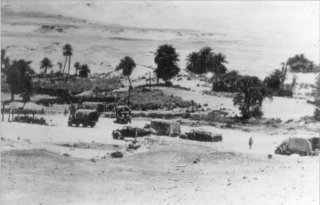
THE OASIS AT KUFRA
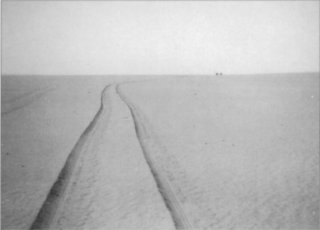
THE DESERT ‘ROAD’ TO KUFRA
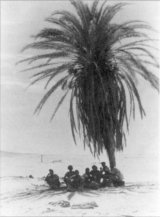
SHADE; HOWEVER SCANTY, WAS ALWAYS WELCOME IN THE DESERT
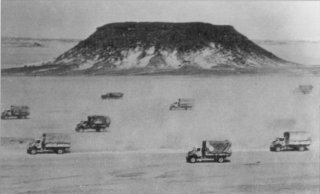
GROUND CONVOY TO KUFRA
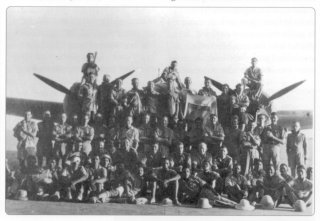
OFFICERS AND GR0UND STAFF OF THE FIRST DETACHMENT, 15 SQUADRON, SAAF
Photo: By Courtesy Maj D W Pidsley)
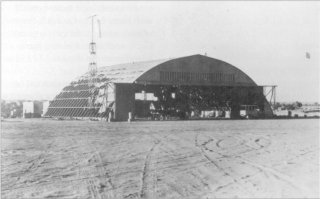
THE HANGAR AT KUFRA

LT COL H H BORCKENHAGEN,
OFFICER COMMANDING 15 SQUADRON, SAAF
AT THE TIME OF THE TRAGEDY.
Day 1 (4 May):
Very early that morning, a weather forecast covering the period from dawn to dusk, and a radius of 200 miles (320km) around Kufra, was obtained from the main weather station at Almaza near Cairn. A copy of this report was handed to each aircrew. Visibility from the air was expected to be 2,5 miles (4km) with a wind speed at 1 600 feet (488m) of 19—24 miles/hour (30—39km/h) from a direction of 60 °rees. Major de Wet refused a further weather balloon test for wind speed and direction. Just after take-off at 06h00, a further balloon test revealed that the earlier forecast was wrong. The wind speed at 2 200 feet (670m) proved to be 31 miles/hour (50km/h) from a direction of 1290.
The take-off was uneventful. As soon as the aircraft became airborne, the ground-to-air radio station at Kufra carried out preliminary checks with Major de Wet’s aircraft, Z7513, and confirmed that it was correctly tuned to the frequency in use. Thereafter until 07h10, this machine did not acknowledge any signals from Kufra, and neither did the other two. This suggested that either the aircraft were not receiving any signals, or that they were not keeping a listening watch.
Flying at 1 200 feet (366m) above ground level, the outside air temperature stood at 100° Fahrenheit (38° Celsius) presaging a hot and bumpy flight. One navigator recorded that the air was so turbulent he was unable to take a drift reading.
Although Rebiana kept a sharp lookout for the three aircraft, they were neither seen nor heard. The crews must have searched the desert below and thought they recognised certain hills resembling those on the maps. Satisfied that the first objective was attained, they set course for Bzema at 06h22 with the same result. Three minutes before the estimated time of arrival (ETA) at LG07, a landing ground became visible which the crews assumed to be LG07. Satisfied that this was their objective, the flight turned towards Kufra, where they were expected to arrive at 07h42, according to one navigator, and at 07h33 according to another. According to the testimony of Air Mechanic Juul, the flight was successful, and they returned to Kufra 2,5 hours later. However, having time to spare, they did not land. They flew away again.
What follows reveals a tragic and disturbing litany of human error and failure, compounded by inclement weather and technical problems, and over it all loomed the pervasive presence of a forbidding Sahara. The story also pays tribute to courage, perseverance, endurance and noble endeavour under extreme circumstances.
The end
At 07h10 on 4 May, on the last leg of the flight to Kufra, the base station picked up signals from the Blenheims, and aircraft Z7610 was heard to ask for a bearing. Base responded by requesting the aircraft to transmit calls and dashes so that an accurate bearing could be taken on those transmissions. It received no reply. At 07h27 the leading aircraft requested the DF station at Kufra to give them a course by which to steer. The aircraft’s radio operator stopped sending the necessary dashes before a proper bearing could be obtained, but a snap bearing was taken. The DF station radioed ‘120-3=0527’. That means ‘steer 120° (zero wind) third-class fix, time 05h27 GMT’. The wireless operator in the aircraft appears to have received only the figures 3, 0 and 5.
At the ETA over Kufra, the aircraft changed course to 305°. After flying on this course for an unknown length of time, during which they were heard by the infantry post west of Taizerbo, at 08h10 they turned and flew a reciprocal course of 125°. At about 09h00 the starboard engine of T2252 started to malfunction, and Major de Wet ordered the flight to make a forced landing. This was successfully carried out at 09h15. Later this position would be established at 24°51'N and 24°25'E.
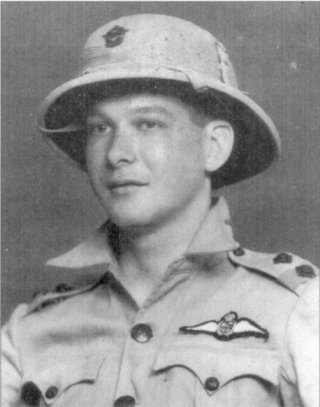
LIEUTENANT (LATER MAJOR) J L V DE WET
(PHOTO: BY FRANCOIS DE WET).
Back at Kufra, the point-to-point radio station reported receiving a faint signal from aircraft Z7610 at 11h00, but this was not picked up by the DF station. The two stations took turns calling the aircraft continuously without response.
At 11h00 one crew took off in Z7610 and flew in a south-westerly direction, but returned after 30 minutes without locating Kufra. Repeated attempts were made to establish radio contact with base, but to no avail. Preparations were made for a second flight, and some fuel was transferred from the disabled T2252 to Z7610.
At 14h00, Lt Wessels took off on a heading of 213° for about 24 miles (40km) and returned after about 40 minutes. At 15h35 a further attempt was made on a course of 240° for approximately 130km, but he could not find Kufra. Had he continued on this heading, he would have seen the oasis. After this flight, it was decided not to make further attempts that day, and preparations were made to spend the night in the open.
With increased concern about the fate of the three aircraft, the garrison commander at Kufra signalled Taizerbo, Zighen and LGO6. Only Taizerbo reported hearing aircraft faintly due west at 08h10, but visibility had been bad and it was therefore unable to determine the direction of the flight. In the absence of any message from the Blenheims to say that they had altered course to 305°, Kufra may have assumed that Taizerbo’s report referred to some other aircraft, possibly of enemy origin.
By midday, the garrison realised that the Blenheims were lost and down somewhere in the desert. But where? This concern was shared by 2/Lt Hoare, the cypher officer of the detachment, and now the only commissioned officer remaining. He sent a signal to 203 Group in Khartoum and the DF stations at Heliopolis and Mersa Matruh, requesting news, but with negative results.
Instructions were then given to organise search parties to be sent to Rebiana, Bzema and LGO7. At 13h10, 203 Group was informed that there was still no news about the missing aircraft. The SDF was assisting, but search aircraft were urgently required. The last request was sent to Wadi Haifa. Should the requirement for search aircraft arise, Kufra would signal again at 18h00.
Throughout 4 May the radio stations at Kufra kept a close listening watch for any signals from the downed machines. At one stage a weak signal was received from T2252, but it did not respond to requests from either station. Some snap bearings were obtained from a moving plane, but transmission was terminated before the all-important dash signals, to establish the location of the aircraft, were received.
Doubtful bearings of 042° and 048°, as well as a second class one at 050° were obtained, and Mersa Matruh obtained one at 203°. The intersection of these bearings was plotted, and a position between 60 miles (96km) and 67 miles (112km) north-east of Kufra was established. The garrison commander responded to this information by sending an SDF patrol under command of Bimbashi (an officer in the SDF) Stubbs to search the probable area. Nine members of the detachment accompanied the patrol.
A signal had already been sent to 15 Squadron, reporting that the aircraft had probably forced-landed for unknown reasons. This message greatly disturbed the OC, who decided to wait until the next day, hoping for better news.
A Bristol Bombay a twin-engined high-wing bomber-transport aircraft — had stopped overnight at Wadi Halfa en route to Khartoum. 203 Group sent a coded signal to Wadi Haifa to detain this machine the next morning, and to await the arrival of a Blenheim from Khartoum with search instructions. This signal was received at 21h40 on 4 May, at which time the cypher officer was off duty. Because it was a priority signal, the radio operator at Wadi Halfa made repeated, but unsuccessful, telephone calls to the officers’ mess some seven miles (11 km) from the airfield. There was also no transport available, with the result that the cypher officer only received the coded message at 08h00. But the Bombay had already departed for Khartoum at 08h15. The OC did not recall the aircraft, but it returned of its own accord on receipt of a signal, presumably from the pilot of an approaching Blenheim. The OC was not available to give the pilot new instructions, and so the Bombay returned to Khartoum. On arrival at Wadi Haifa, the Blenheim became unserviceable.

A BRISTOL BOMBAY, ONE OF THE AIRCRAFT INVOLVED IN THE SEARCH
Day 2 (5 May):
Major de Wet had all the fuel drained from T2252 and transferred to Z7513. 2/Lt I H Pienaar and his crew took off and searched unsuccessfully on a bearing of 90° from the stranded aircraft for a distance of about 45 miles (72km). On their return, the position was re-evaluated, and Lt Pienaar was instructed to fly on a bearing of 290° for a distance of about 96 miles (160km) because the west was the only direction which had not been searched. Apparently the fuel position became critical, forcing Lt Pienaar to turn back. With the available engine power he forced-landed about 24 miles (40km) north of the stranded party.
At O7h00 that morning, Bimbashi Stubbs and his party, which included the nine members of the detachment, set off from Kufra to search the probable position previously obtained. In the afternoon, they picked up a strong signal from one of the missing Bienheims, and confidence surged that rescue was imminent. The very rough and broken terrain over which they searched compelled them to remain within sight of each other, hampering the effort considerably. Bimbashi Stubbs signalled Kufra to this effect. An air search became essential, in the meantime, the search parties from Rebiana, Bzema and LGO7 returned from an unsuccessful mission.
During the night, Major de Wet and his men fired pyrotechnic light cartridges from the Verey pistols, and at times bursts from the turret guns, to attract the attention of possible searchers. There was practically no shade in which to rest, and the intense heat added to the discomfort of the men. The wind strength also increased, and soon a dust storm was blowing.
Day 3 (6 May):
Major de Wet issued the last water a bottle (about 1,25 litres) per man. Tormented by thirst and the blazing sun, they drank the oil from tins of sardines and the syrup from tins of canned fruit. They were unable to eat anything. In the morning, Major de Wet took off in the last serviceable Blenheim, Z7610, on a bearing of 290°, but returned to the emergency position after a fruitless search. RAF Headquarters ordered three Bristol Bombays from 216 Squadron to proceed from Khanka to Kufra via Wadi Haifa, while 203 Group sent a senior officer to meet them there. But fate intervened. Due to engine trouble, this officer was forced to land next to the railway line. He boarded the first available train, which happened to be a goods train. When he finally arrived at Wadi Halfa, two Bombays had already left. The third had developed engine trouble and had returned.
At 11h00, and approaching Kufra at 3 000 feet (980 metres), the Bombays discovered that a sandstorm had blown up. This reduced visibility at that altitude to 50 feet (16m). They flew blind past Kufra, turned back on a reciprocal heading, hoping to see the oasis. They did not succeed, and proceeded until they could see sufficiently well to make a forced landing. They eventually landed at Kendall’s Dump at 16h30 and at a distance of about 40 miles (64km) south-east of Kufra. Here they waited for the storm to subside. They also did not know the call sign of the newly established DE station at Kufra. The sandstorm kept them grounded for two days, and they were forced to return to Wadi Halfa because their fuel was low and their batteries needed re-charging.
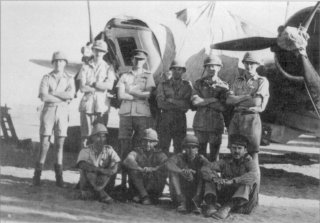
RELIEF FLYING CREWS, L TO R: LTS J STEENKAMP & H HOARE,
MAJ TAFFY JONES, A N OTHER, LTS C HARRISON & P DAPHNE.
SEATED, L TO R: F/SGTS A GREGOR, M W PRIDAY & A ROGER, LT B MOORE
(PHOTO BY COURTESY EDDIE HALL)
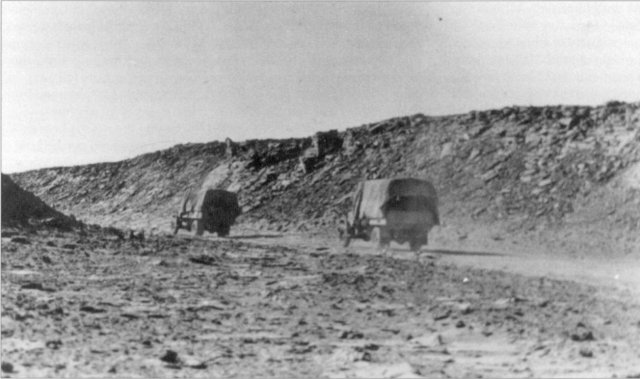
THE TERRAIN ENCOUNTERED BY THE GROUND SEARCH PARTIES MADE AN AIR SEARCH IMPERATIVE.
Day 4 (7 May):
The senior SAAF NCO, Sgt Cox, reported visibility dropping at times to 100 feet (30m). Since no search aircraft had reached Kufra, the garrison commander sent out another patrol under Bimbashi Tarbett to proceed to Jebel Alima and to link up with the previous party. Meanwhile, back at 15 Squadron, Lt Col Borckenhagen grew impatient at the delays and decided to fly to Wadi Halfa. On his arrival, he found it engulfed in a sandstorm. To attempt to reach Kufra under such conditions, and with a questionable DF station, would be courting disaster. He was forced to delay his departure, hoping for an improvement in the weather. He was, however, able to maintain contact with the Long Range Desert Group regarding progress with the search and weather conditions at the oasis.
Towards the evening, RAF Headquarters Middle East reacted sharply to the delays being experienced, and 162 Squadron RAF Bilbeis in the Canal Zone was ordered to provide a Wellington aircraft to assist the search. This machine developed engine trouble, and was forced to return to Bilbeis where another Wellington was provided.
Day 5 (8 May):
The ground search parties under Bimbashis Stubbs and Tarbett made contact in the probable area of the missing aircraft. Joint patrols were carried out during the day - visibility having improved considerably. At one time or another between 5 May and 9 May, the search parties were within two miles (3,5km) of the main stranded group and within five miles (8km) of the third Blenheim. But the nature of the terrain, the sandstorm, and the lack of co-operation from the grounded crews, prevented rescue.
In his diary Major de Wet recorded: ‘Boys are going mad wholesale. They want to shoot each other. Very weak myself. Will I be able to stop them from shooting each other and stop them from shooting me? ........... give us strength. Six of us left out of 12. No water. We expect to be all gone today. Death would be welcome. We went through hell.’
The second Wellington, piloted by Sqn Ldr D G Warren, left Bilbeis and flew directly to Kufra, arriving there at 14h30. it also experienced difficulties getting bearings from the DF station. It had been given the wrong call sign. After the relevant factors were discussed, the aircraft took off from the oasis to the most likely position previously determined. It did a square search of an area approximately 20 miles (32km) in radius about this point. Nothing was found.
Lt Col Borckenhagen was able to persuade the SDF commander at Wadi Halfa to place a vehicle and driver at his disposal to take him to Kufra. He recalled that: ... accompanied by a young British officer in one pick-up van, and led by another manned by a SDF soldier, I left Wadi Haifa at 15h00. The sandstorm continued unabated, reducing visibility to 100 yards (30m). After almost 36 hours of continuous driving, and without changing drivers, we arrived at Kufra at 03h00 on 11 May.
At the stranded aircraft, Major de Wet records in his diary: ‘Only me, Sgt Shipman and A/M Juul are still alive. We can’t last if help does not arrive soon. They know where we are but do not seem to do much about it. Bit of a poor show isn’t it ...... but we will stick it out to the very ...........’ From this point it is impossible to know the date.
Day 6 (9 May):
Sqn Ldr Warren took off early on the morning of 9 May and returned to the probably fixed position. After a further 5,5 hours, he spotted the single Blenheim Z7513, located 25° 11' N/24° 07’E. He landed alongside it and found the bodies of the crew - 2/Lt J H Pienaar, 2/Lt F J Reid and A/Sgt W W Oliver - lying in the shade of a wing. A medical officer who accompanied the flight diagnosed death by exposure and/or thirst, possibly on the previous day. Everything pointed to a fearful struggle to survive.
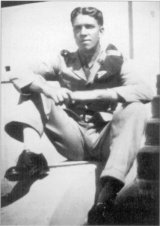
A/SGT WALLACE WILLIAM OLIVER
(PHOTO: BY COURTESY MRS J M PIENAAR)
No navigator’s logbook was found — only the rough pencil sketch of a map on which was drawn a prominent hill feature, and from which tracks of 213° and 233° had been marked. From these findings an assumption can be made that the aircraft had landed elsewhere before the final touchdown. The question why the crew did not return to the stranded party remains unanswered.
Using this rough sketch as a guide, Sqn Ldr Warren took off. He searched an area with a radius of about 15 miles (24km). Finding nothing he returned to Kufra, refuelled, and resumed the search on a bearing given by the DF station at Suez Road, but returned after two hours.
In his diary, Major de Wet had written: ‘It is the fifth day. The second without water, and the fifth in a temperature well above 100° Fahrenheit (38°C). But Thy Will be Done, O Lord.’
Day 7(10 May):
At 03h00 on the morning of 10 May, the ground search patrols in the area of the missing Blenheims received a signal informing them that aircraft Z7513 had been found. Bimbashi Tarbett, accompanied by the nine members of the detachment, were directed there. This party searched the whole day, but was unable to locate the aircraft. A signal was sent to Kufra requesting an aircraft to direct them.
Meanwhile Sqn Ldr Warren took off again and searched an area about 100 miles (160km) from Kufra on a reciprocal to 290° on the strength of the information obtained from the sketch map found at the single machine. Finding nothing, he returned to Kufra.
Another Blenheim from 15 Squadron, piloted by Lt Steinberg, was en route from Wadi Halfa to assist with the search. By midday, two Bombays and another Wellington arrived. Sqn Ldr Warren detailed one Bombay to search an area south and east of Kufra, and the other to the Gara Dalmo/Wadi el Blata area about 120 miles (200km) away on a heading of 130°. He himself returned to the area halfway along the Eight Bells Landing Ground/Kufra track. During this flight he noticed certain hill features resembling those shown on the sketch map found at Z7513. He reasoned that the crew had probably mistaken a landmark. By this time it was late in the afternoon and he returned to the oasis.
Day 8 (11 May):
At 07h00 on 11 May, an aircraft arrived over the ground patrol and directed them to Z7513, which they reached at 1OhOO. Here they carried out another thorough check of everything found at the site. Two maps of the Kufra area were later handed to Lt Col Borckenhagen. The bodies of the three crew members were buried next to the Blenheim. The Bombays continued to do square searches in the areas previously allotted to them, and the Wellington searched an area between the Blenheim already found, and Taizerbo.
Sqn Ldr Warren, however, returned to the single Blenheim. From this position he flew in turn courses reciprocal to those shown on the sketch map — 033° and 055° in the hope of finding the main stranded party. The search was unproductive. He returned to the stranded aircraft, and from there set course for the hill feature which he thought resembled that shown on the sketch.
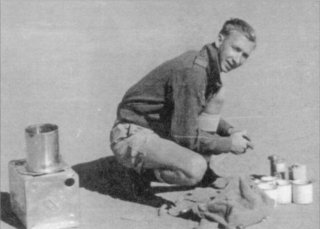
AIR MECHANIC N St M JUUL,
SOLE SURVIVOR OF THE KUFRA ORDEAL
Back at Z7513 the ground party prepared to bury the crew near the aircraft. While they were doing so, a Wellington arrived, informing them of the discovery of the other two machines.
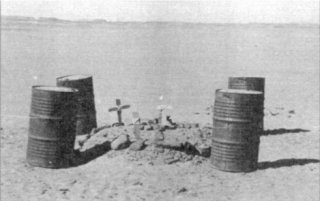
THE GRAVES 0F PIENAAR, REID AND OLIVER, AT
THE SITE OF Z7513
(PHOTO: MR M W PRIDAY).
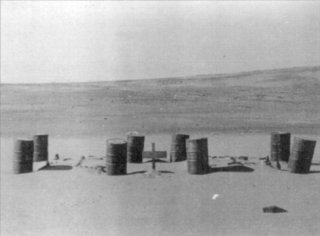
THE GRAVES OF THE AIRMEN FOUND AT THE SITE
OF Z7610 AND T2252
(PHOTO: M W PRIDAY)
At 1OhOO, while the search party made preparations to bury the dead, a Wellington landed with Lt Col Borckenhagen on board. He read the final rites at the burial service. He recalled that ‘it was a very emotional experience’. After the service, all the personal effects of the deceased were handed to the officer commanding and the parties returned to Kufra.
The fate of the aircraft
There is only one, incorrect, report regarding the Kufra incident, it was compiled by the late Maj D W Pidsley and submitted to HQ chief-of-staff in February 1961. It is now preserved at the Air Force Museum at Zwartkops. The reason it is incorrect is that the pages of the Kufra War Diary covering May 1942 were impounded by the Court of inquiry and subsequently filed at the Public Records Office in London. The major never saw these pages when he was given command of the detachment in June 1942. He was taken ill and returned to the squadron almost immediately. According to Maj Pidsley’s report, the two aircraft, Z7610 and T2252, were still in the desert. His report is patently incorrect and must, for the sake of history, be rectified.
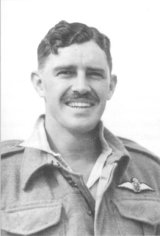
Maj D W PIDSLEY
Aircraft Z7513 was abandoned in the desert where it was found because the engines were over-boosted. After an enemy attack on Kufra on 25 September 1942, this machine was cannibalised and its parts used to repair a Bisley damaged during the raid. In February 1959, a geological field party re-discovered this machine. At that time, it was presumed that the wreck would last for years, protected by the low humidity and engulfed in the drifting sand of the Sahara. The bodies of the three crewman were then exhumed and re-buried in graves numbered 20, 21 and 22, row F, plot XIII in the Knightsbridge Cemetery, Acroma, Libya.

EVIDENCE OF THE STRUGGLE TO SURVIVE: A PARTLY EXPOSED PARACHUTE,
FIRE EXTINGUISHER, OXYGEN BOTTLE, AND RATION TIN
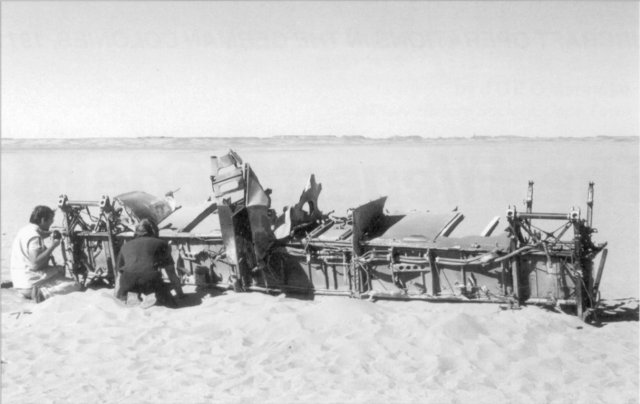
THE CENTRE SECTION OF THE MAIN SPAR OF THE BLENHEIM Z7513,
A SAD REMINDER OF THE KUFRA TRAGEDY
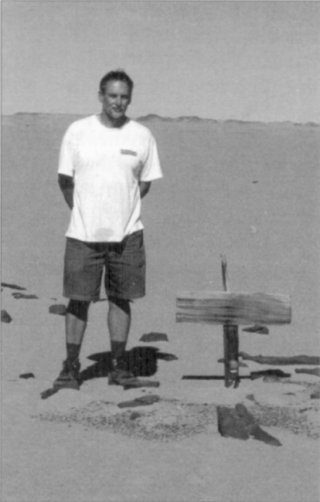
FRANCOIS DE WET AT HIS UNCLE’S DESERT GRAVE. HE HOPES TO RETURN HERE TO ERECT A SUITABLE MEMORIAL.
An inquiry was conducted at Kufra from 1 to 4 June 1942.
The causes of the accident were attributed to:
1. Lack of experience in desert flying by pilots and observers.
2. Failure by observers to keep accurate navigators logs.
3. Inability of wireless operators to carry out their duties in the air.
The reasons for the failure of both ground and air searches were attributed to a lack of accurate information regarding the possible position of the aircraft; difficult terrain; sandstorms; unserviceable aircraft; and poor signal organisation.
The assistance given by the forced-landed crews was:
1. Bad DF procedures even on the ground.
2. Lack of visual signals and smudge fires.
The reasons for the early death of personnel were:
1. Failure to appreciate their plight.
2. Failure to ration water immediately.
3. Unintelligent use of compass alcohol and fire extinguishers.
The responsibility for the forced landing was attributed to the crew of the leading aircraft. To prevent a reoccurrence of such a tragedy, the board made comprehensive recommendations with regard to equipment to be carried on aircraft likely to fly over the desert, and emergency procedures in the event of forced landings. Only experienced crews were to be based at Kufra, and strict procedures were laid down for operations from there.
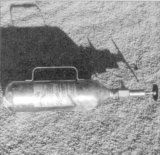
FIRE EXTINGUISHER (USED BY THE DESPERATE MEN TO COOL THEMSELVES)
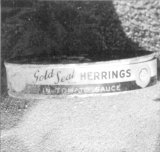
TIN OF HERRINGS IN TOMATO SAUCE (THE STRANDED MEN DRANK THE LIQUID, UNABLE TO EAT ANYTHING)
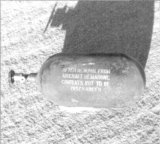
OXYGEN BOTTLE (EMPTIED)
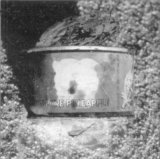
TIN OF SINGAPORE PINEAPPLES (LABEL STILL LEGIBLE AFTER ALMOST 60 YEARS)
Return to Journal Index OR Society's Home page
Addendum: 25 Feb 08. Tom Sheppard, Hitchin. UK
I have just come across the 'Tragedy at Kufra' piece in the South African Military History Society Journal, Vol 12, No 2 - the most comprehensive account I have seen of the loss of the three Blenheims. It certainly lends perspective to the story as usually told.
The recovery of the three bodies from the lone aircraft was effected, I believe, by the RAF Desert Rescue team (No 1 Field Squadron, RAF Regiment, Sqn Ldr J R Spencer) from RAF El Adem in 1959. I was part of a group mounted by the same unit in 1960 (Sqn Ldr Mike Burgess) charged with finding the eight remaining graves. Homing in on the remains of just the solo Blenheim we failed to find them, of course; at that time there was no knowledge of the whereabouts of the landing site of the other two aircraft in relation to the first.
Your account mentions that the lone aircraft had obviously been destroyed by fire but it seemed to me the main structure had simply been vandalised and most parts just been taken away. There was no sign of fire. I attach a picture I took at the time - one of No 1 Squadron's Series 1 Land Rovers with l to r Sgt Ballam, Senior Aircraftsmen Minshell and Brown; the same structure featured in your report. April/May is the windiest time of year in the Sahara and the visibility at the time I took this photo (Nov 1960) makes you realize what it must have been like for the crews and searchers.
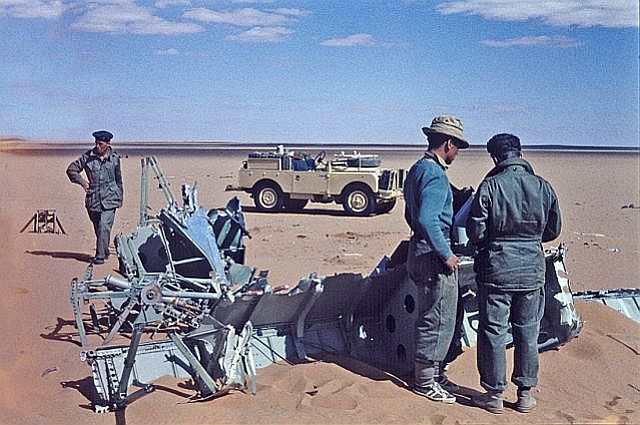
No 1 Squadron's Series 1 Land Rovers with l to r Sgt Ballam, Senior Aircraftsmen Minshell and Brown
There's also a small inconsistency in the position of the original landing of the three aircraft (given as 24.51N, 24.25E) and the position of the two later found by the Wellington (24.49N, 24.10E); these two positions should of course be the same. I'm sure Sqn Ldr Warren had an awful lot on his mind when he finally saw the two Blenheims after three previous trips and five and half hours squinting out at the desert but presumably both positions are what the respective navigators came up with after a DR plot-out.
As a frequent (very careful) Sahara traveller and ex-RAF pilot I found your account absorbing and very moving
Addendum: 28 Dec 2014. John Lloyd - Squadron Leader RAF (Retired)
I was based at RAF El Adem just south of Tobruk from 1963-65. In 1963 the RAF were asked by the UK War Graves Commission to try and locate the burial site of Major De Wet and the crews of Z7610 and T2252 for exhumation and reburial at the Knightsbridge Cemetery Tobruk (photos below), as had happened with the crew of Z7513 in 1959. I was 2 I/C of the Desert Rescue Team in October 1963 when we successfully located the site and exhumed the airmen.
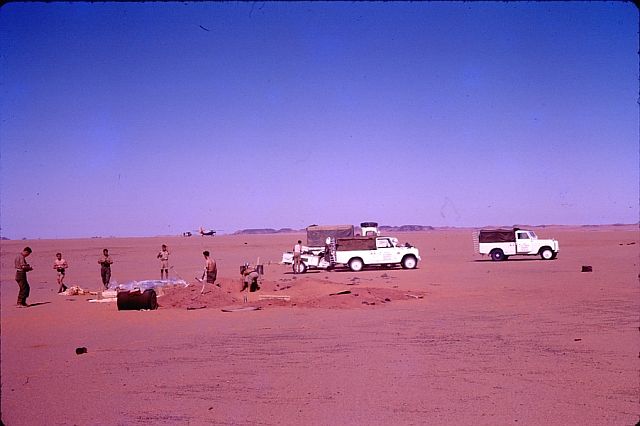
1963 Successful exhumation expedition
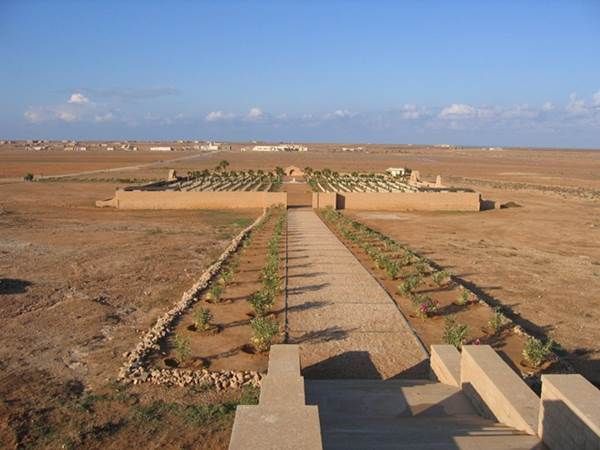
Knightsbridge Cemetery, Tobruk
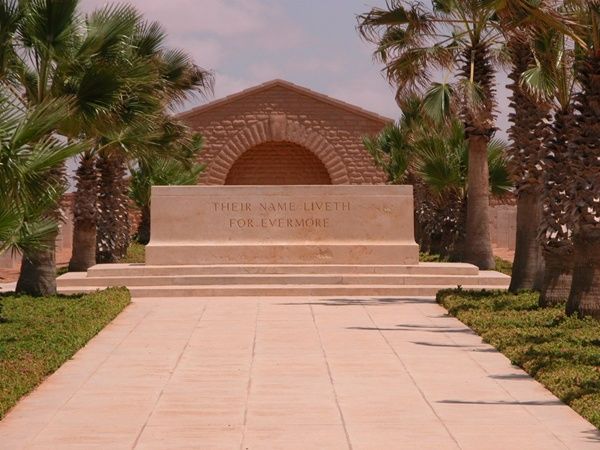
Knightsbridge Cemetery, Tobruk
South African Military History Society / scribe@samilitaryhistory.org